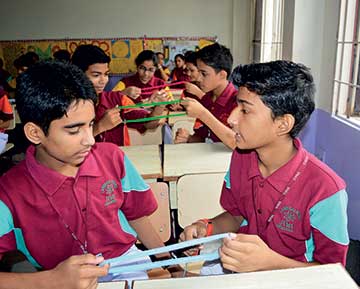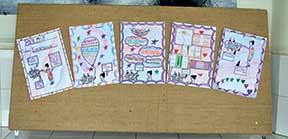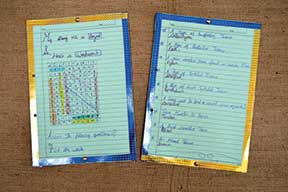Devina Nigam
In our school, we help children explore different self-paced learning methods and choose the ones which he/she finds interesting. The teacher acts as a facilitator and ensures that fun components are added in classroom activities which are done individually or in groups. The teachers give several options to the children which stimulate different intelligences and develop higher order thinking skills such as remembering, analysis, synthesis, etc.
The objective is to help children overcome the stress and pressure of exams and to break the monotony of rote learning by using a modern curricular approach which enhances the multiple natures, i.e., creative, entertaining, providing, and adventurous.
The teacher prepares a lesson plan for each activity and gives instructions to the students.
Activity
Spin the yarn (a question and answer activity inside the class which improves interpersonal skills)
Method
- Students can choose the subject. It can be social studies for class VI or EVS for class III.
- Students have to check the topic.
- Students have to revise the topic thoroughly in class.
- Students have to prepare at least five questions on the topic. Subjective questions can be prepared for social studies and objective questions can be thought of for science.
- Students have to take a ball of yarn or wool, divide themselves into pairs or groups and give numbers to each member.
- In a group, choose the leader and start questioning clockwise.
- The leader has to start questioning and spinning the yarn by passing the thread to each child who gives the answer. The same can be done in pairs by altering chances.
At the end, check who gets the longest yarn and give a star as a motivator to good performers.
This activity helps students learn how and what to ask by analyzing a given topic. Such activities help children revise their lessons without pressure before the exams. All that is needed is a ball of yarn or wool which makes learning an enjoyable experience. This activity is helpful for slow learners.
Activity
Story time with puppets (A linguistic activity)
Method
- Students can prepare hand puppets of different characters or make animal puppets, i.e., rabbit, monkey, tiger, lion, etc.
- The students will use the puppets to enact/tell a short story in Hindi or English. They can be first divided into groups.
- Each group will choose its own subject and topic.
This activity helps students use their imagination and express themselves. It helps them develop critical thinking skills when they try to analyze the different shades of characters in a play or story. By using puppets you get the opportunity to practice theatrical skills, i.e., voice modulation in a classroom. A teacher can experiment by presenting a novel situation where the characters transform or change themselves, for instance, from being selfish to becoming caring, from being arrogant and rude to becoming polite and humble.
A fair part of the language syllabus can be revised either on stage or in class by students themselves where each catches up with his/ her own self-paced learning approach. A teacher will be more of a mentor helping in choosing topics and creating opportunities for students to improvise and innovate.
Activity
Smart choice (A creative activity exploring different multiple intelligences)
Method
Students will use their strong MI and MN to explain a given topic, which can be either from biology, physics, geography or any other visually appealing subject.
The teacher can divide the class or students into groups or pairs with matching intelligence, e.g.: a musical group, a logical group, a visual graphic group, linguistic, and so on.
Each group can now present the topic using its chosen intelligence. The musical linguistic group can create its own poem or story, the logical group can prepare a board game or crossword, the visual graphic group can create a graphic comic or a table calendar.
This activity has immense scope which can be explored wisely by the teacher by just creating a congenial atmosphere in the classroom where the child can come up with the best of him/herself. This activity has been conducted several times by science teachers and every time it has produced fantastic results. The children are able to reach creative heights at the end of the activity and the teacher leaves the class happy and satisfied.
The author is Headmistress, Jiva Public School. She can be reached at devinanigam27@gmail.com.



